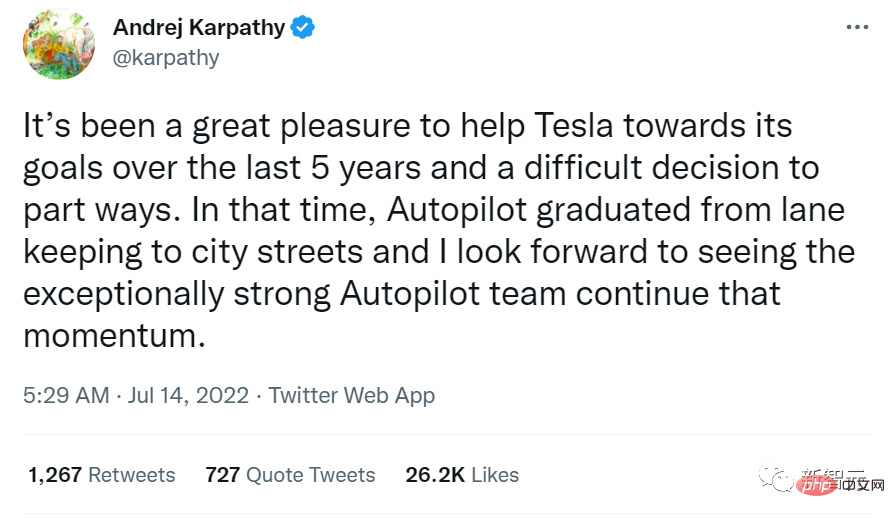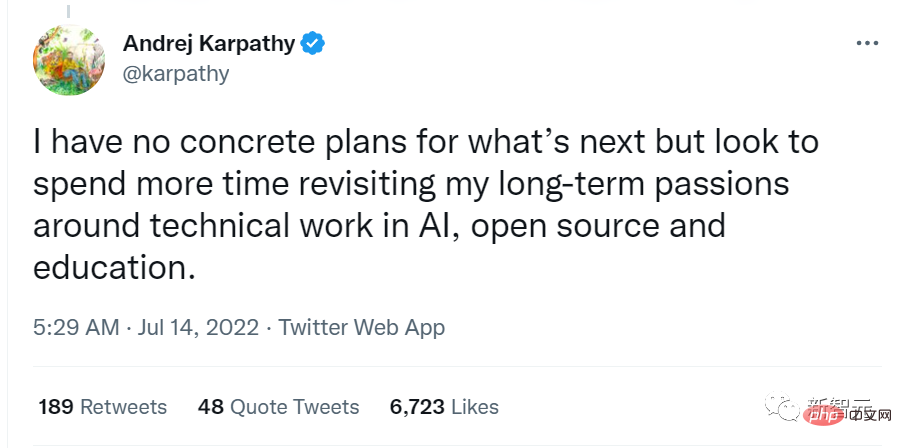Home >Technology peripherals >AI >Tesla's former AI director Karpathy reveals his departure and pure vision solution
Tesla's former AI director Karpathy reveals his departure and pure vision solution
- WBOYWBOYWBOYWBOYWBOYWBOYWBOYWBOYWBOYWBOYWBOYWBOYWBforward
- 2023-05-16 11:28:06652browse
Tesla’s former Artificial Intelligence Director and new AI Internet celebrity teacher Andrej Karpathy recently participated in the podcast of MIT artificial intelligence expert Lex Fridman. For artificial intelligence enthusiasts, this interview can be described as "double chef ecstasy".
In the nearly three-and-a-half-hour interview, the two discussed grand topics such as artificial intelligence, the universe, and human society. They also discussed in detail many of Tesla's technologies, such as autonomous driving. Driving, Optimus humanoid robots, and Tesla vision solutions. In addition, the two also talked about Andrej's resignation, which the audience is most concerned about, and the reason why Tesla canceled the ultrasonic radar.
No need for radar: it’s expensive but hard to use!
Tesla removed millimeter-wave radar from the sensor suite last year, and has just announced that it will remove all ultrasonic radars, retain only cameras, and adopt a purely visual solution. Lex asked: "Does this make it harder or easier for the vehicle to detect the road?" Karpathy said: "People generally think of these sensors as an integral asset of the car. , but if the integrity of the product is fully considered, these sensors are actually a potential burden."
"These sensors are not free and cannot appear in the car out of thin air. Not only do they need A complete supply chain also needs someone to be responsible for procurement,” and these all cost real money.
At the same time, the sensor may fail and need to be replaced. "As part of car manufacturing, the production of sensors can also drag down the overall schedule. So, not only do you need procurement and maintenance, but you also have to have a team to write firmware."
Not only that, use Radar sensors also complicate detection systems. "Incorporating them into a car system will lead to overbloat of the overall system," Karpathy said. Installing so many sensors also puts pressure on the data engine. As developments continue to occur over time, the functions of sensors become increasingly refined. "There are too many radars now, each with different functions. This has caused overexpansion of the detection system. In addition, too many radars will interfere with each other and affect the effect."
He highly praised his former boss Musk's ability to simplify the complex, "I think Elon is very good at simplifying. He once said: 'The best parts are no parts.' He will always try to get rid of things that are not important." , has been doing subtraction, because he understands the entropy increase phenomenon of the organization."
The cost is high, there are many problems, and people need to constantly repair it. It will also bring about the complexity of the detection system. In this case, the cost of installing radar is high and there is not much development potential.
"As a computer vision engineer, if you want to improve the vehicle detection network, you will consider whether adding sensors is useful and how useful it is. We conduct comparative experiments to truly determine whether radar can provide car owners with Provides very useful traffic information. But the results show that the difference is not big, which shows that radar is not useful."
Karpathy not only explained why Tesla abandoned this technology, but also asserted that Other car companies will make the same choice. "Similar to lidar, I don't think ultrasonic radar can provide a lot of additional information. I think other companies that are still using lidar will abandon this technology."
Purely visual solution: better One Chip
Karpathy has high hopes for purely visual solutions. "If we choose a pure vision solution, we can concentrate all resources and build a powerful data engine.""The bandwidth of this sensor is very high, and we have made substantial progress in this regard. By investing heavily in the technology, you can achieve extraordinary results."
Karpathy said a purely visual approach is both necessary and sufficient. In a sense, the world is designed for human visual consumption, and people have visual needs.
At the same time, this solution can provide all driving information needed by all drivers. "So we have to focus our resources on developing this technology and keep asking ourselves: 'Do I really want to introduce other sensors?' I think the answer in this case is no."
Although the pure vision solution has received strong support from Karpathy, when Lex asked how he viewed the difference between lidar and pure vision solutions, as well as point clouds and voxels, Karpathy said frankly: The two are not autonomous driving. the key of.
He said: "I have never understood this debate. Because it is not the core of the problem. I think everyone should pay attention to whether there is a road test fleet as support when discussing automation. This is It is the key to whether the artificial intelligence system can provide better services."
Therefore, when considering the detection capability of the sensor, it must be comprehensive. Including whether it can provide a road test fleet to collect large amounts of data, whether it can integrate sensors and data, and integrate sensors into the data engine to achieve rapid search of different parts of the data, and then continuously improve the models used.
Centimeter level map: No need!
When asked what he thought about other companies producing high-definition maps of self-driving cars in their operating areas, Karpathy said: "It's crazy!"
" We have been talking about how autonomous driving will change the world and how this technology can be applied to transportation on a global scale. If you need to continuously provide a centimeter-level accurate map of the world or a city and keep it updated frequently, the cost is too high."
When Lex asked whether this approach would be extended to all regions of the United States, Karpathy used the example of Tesla to explain: "People don't need such a high-precision map. A low-precision map The map is enough to show key information such as road conditions and road sections ahead. Drivers can understand their environment through this key information just like looking at Google Maps."
"Tesla's driving system uses information with a similar resolution to Google Maps. But it does not pre-draw maps with centimeter-level accuracy. This approach is superfluous, thankless, and dilutes the team's capabilities, preventing technical staff from focusing on what is really necessary, which is Computer vision problem."
Will you come back after leaving your job? This is love
When talking about why he left Tesla, Karpathy said it was a difficult decision. Although Tesla has not yet fully implemented autonomous driving, the R&D team has been able to develop on its own. This resignation also gave him an opportunity to re-examine his love for artificial intelligence, open source and education.
Previously, he had worked for Tesla for 5 years and reported directly to the big boss Musk. Among Tesla executives, he is definitely considered a veteran. . According to reports, Li Feifei's disciple had been on vacation for several months. He had previously said that he would return to Tesla after his vacation in the near future, but he immediately announced his resignation.

Karpathy said: "I am very happy to help Tesla achieve many goals in the past five years. The decision to leave is actually a difficult choice. . In the past 5 years, autonomous driving has completed its "graduation". It started from staggering to find a way and drove onto the streets of the city. I look forward to the future of a more powerful autonomous driving team to continue to be glorious."

Regarding his future plans after leaving his job, he said: "There are no specific plans for the future. I may return to areas where I have long-term passion, such as AI technology work, open source and education, etc. ."
Of course, he also mentioned the possibility of returning to Tesla in the interview: "Maybe at some point I will come back and work on Optimus or AGI at Tesla. (General Artificial Intelligence) work. Tesla will be an amazing company that can create extraordinary things. At this massive robotics company, talented designers are creating new things that have never been done before."
From a Tesla executive to an internet celebrity teacher, Karpathy can leave Tesla for artificial intelligence, or he can return to work one day for humanoid robots and AGI. What he pursues is not material and status, but the continuous advancement of technology. This is similar to the behavior of his mentor Li Feifei who refused to change careers after graduation and stuck to computer image recognition research. Perhaps, this is "like a teacher, like a disciple"!
The above is the detailed content of Tesla's former AI director Karpathy reveals his departure and pure vision solution. For more information, please follow other related articles on the PHP Chinese website!
Related articles
See more- Technology trends to watch in 2023
- How Artificial Intelligence is Bringing New Everyday Work to Data Center Teams
- Can artificial intelligence or automation solve the problem of low energy efficiency in buildings?
- OpenAI co-founder interviewed by Huang Renxun: GPT-4's reasoning capabilities have not yet reached expectations
- Microsoft's Bing surpasses Google in search traffic thanks to OpenAI technology

